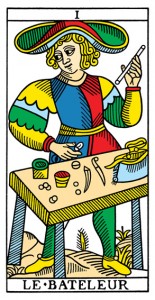 There is magic in the Tarot. This mysterious set of 78 cards, originally popularized as a humble means for games of chance, has captured the imagination of many over several centuries. Some have used the cards as an instrument for divination and fortunetelling. Others have seen the Tarot as a secret repository of ancient and powerful knowledge. Today many people use the Tarot cards as a tool for consultation, guidance and decision-making. There are also those who employ them as a visual aid for guided imagination and meditation, or as magical amulets. And in the course of these centuries, countless human lives have been touched, and sometimes transformed, by the reading of the Tarot cards.
There is magic in the Tarot. This mysterious set of 78 cards, originally popularized as a humble means for games of chance, has captured the imagination of many over several centuries. Some have used the cards as an instrument for divination and fortunetelling. Others have seen the Tarot as a secret repository of ancient and powerful knowledge. Today many people use the Tarot cards as a tool for consultation, guidance and decision-making. There are also those who employ them as a visual aid for guided imagination and meditation, or as magical amulets. And in the course of these centuries, countless human lives have been touched, and sometimes transformed, by the reading of the Tarot cards.
I have been with the Tarot for 34 years: reading for people, teaching, writing, experimenting. I am still learning the Tarot cards. The subtle intricacies of their illustration details continues to surprise me. New and unexpected meanings continue to emerge. And I am still amazed whenever a person opens up and shares his or her most intimate feelings in a reading session, when “just the right card” appears for someone in need, or when an unexplained but meaningful coincidence (or “synchronicity event”) happens in the presence of the Tarot cards.
And yet, if asked what is the Tarot, I would say that first of all it is a work of art. Not like a painted picture, framed and hung as a finished product which cannot be changed. Rather it is a capricious set of images to be handled and played with, evolving over many generations through the collective efforts of deck creators and visionaries. It is a wonderful work of art, rich and flexible enough to span the whole range of human experience – from our innermost feelings to the external events of everyday life. And it is through this art, in the details of the card illustrations, that the magic of the Tarot is revealed.
The object of this book is threefold. First, it is a general introduction to the Tarot cards and the reading process. As such it can be relevant whether you want to read the cards yourself or if you are interested in Tarot reading as a psychological device, as a cultural phenomenon, or as a way to find meanings in a work of art. Second, it is a primer for a method of Tarot reading that I call “the open reading”, based on looking at the illustrations rather than learning fixed interpretations of each card by heart. The open reading can be applied to different kinds of Tarot cards, although it works with some more effectively than with others. Third, it is a handbook for reading the Tarot de Marseille which is the classical version of the traditional Tarot. In particular it uses the CBD Tarot de Marseille, an edition of the cards that I restored from the most influential historical deck originally published by Nicolas Conver in 1760.
Welcome.